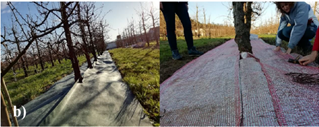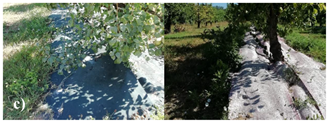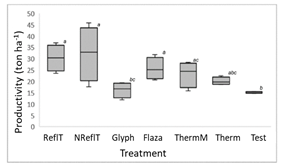INTRODUCTION
The search for alternatives to chemical weed management has increased due to the excessive and continuous use of herbicides that are known to have several consequences for ecosystems, and promotes herbicide weed resistance (Merfield et al., 2017). These alternatives need to be effective, easy to apply, economically viable and sustainable (Westwood et al., 2018). There are diverse non-chemical options for weed management such as crop rotation, false sowing, soil covering (mulching), mechanical weeding and thermal weeding. Although some authors are making research efforts on these issues (e.g. Rifai et al., 2002), there is still a lack of knowledge on the efficacy of these methods in row crops, such as orchards. Thermal weeding can be done by flamming, or using hot water or steam, and consists of heating weeds to high temperatures, leading to the collapse of their cells (Ascard, 2007). The first thermal weeding methods began to be patented in 1852 and were widely used in the USA until the appearance of the first selective herbicides. In Europe, with the emergence of organic agriculture in the eighties, this method began to gain relevance (Collins, 1999). Nowadays, with technological advances, a new window of opportunity for thermal weeding arises. Another potentially successful alternative method is the use of mulching tarps, but the effects and economic feasibility on orchards have not been thoroughly investigated. Mulches prevent penetration of light or exclude certain wavelengths that promote the germination and growth of seedlings, while increasing soil temperature and retard the loss of soil moisture. This work aims to study the efficacy of diverse weed control methods in a pear orchard (Pyrus communis L.), Alcobaça, Portugal. Specifically, we compared the use of light-reflecting and non-reflecting tarps, thermal weeding using steam at 100 ºC, with two herbicide treatments and a control (untreated).
MATERIAL AND METHODS
Study area, experimental design and trial
The field experiment was conducted at the National Station of Fruticulture Vieira Natividade, Alcobaça, Portugal (39.552 N, 8.960 W), in a 22-year-old pear orchard (Pyrus communis L. cv. ‘Rocha’). It was conducted in a randomized block design for five of the seven treatments and with four replications (20 m2; 10 trees). The treatments were as follows: i) thermal treatment with prior weed mowing (ThermM); ii) thermal weeding without prior weed mowing (Therm); iii) mixture of systemic foliar and residual herbicides: (Ghyph); iv) residual systemic and foliar herbicide: flazasulfuron (Flaza), and v) untreated control (Test). The two remaining treatments referred to two different tarps (non-reflecting mulching tarp, NReflT, and reflective mulching tarp, ReflT) which were installed in contiguous rows and the replications were randomized within the rows. This option was made due to material limitations. The trial was carried out between November 2019 and July 2020 (Table 1).
Table 1 Treatments applied during the trial, acronyms, dates and details. a.i.- active ingredient
| Treatment | Acronym | Date | Herbicieds and dose rate applied |
| glyphosate + diflufenican+MCPA | Glyph | 27.11.2019 | glyphosate + diflufenican + MCPA (160 + 40 + 500 g a.i. /100 L water) (ZarpaTM, Basf + HERBINEXA 50, Nufarm) |
| glyphosate | 22.05.2020 | glyphosate (360 g a.i. / 100 L water) (RoundUP Ultra Max, Bayer Crop Science Portugal) | |
| Non- Reflective tarp Reflective tarp | NReflT ReflT | 20.01.2020 | date refers to the day of the installation |
| flazasulfuron | Flaza | 20.02.2020 26.05.2020 | flazasulfuron (200 g a.i. / 100 L water) (ORFEU, Selectis) |
| Thermal weed control with mowing of weeds | ThermM | 20.02.2020 26.06.2020 | mowing: 22.05.2020 |
| Thermal weed control without mowing of weeds | Therm | 20.02.2020 26.06.2020 |
Thermal weeding was applied using the ‘Belle Île OliaTec’ equipment (provided by the company Terramotriz, Alcobaça, Portugal). It has a 500 L water tank that is heated with a dieasel generator. The water is applied using a hose that connects to a plastic gun and equipment similar to a ‘vacuum cleaner’ with five nozzles (Figure 1a). The estimated average working speed for applying thermal weeding with and without prior cutting of the weeds is 0.22 km/h and 0.14 km/h, respectively. The average time is 2.71 and 4.31 min to treat 10 m in mowing and non-mowing modes. Based on these values, water consumption per hectare was estimated at around 7000 L in the case without cutting and 3600 L with prior cutting of the weeds. NReflT (dark green) and ReflT (pinkish-white) are 0.64 mm and 1.32 mm thick, respectively and are both thermally welded polypropylene, permeable to water, allowing gaseous circulation and nutrient absorption (Figure 1b).


Figure 1 a) Equipment used in thermal treatments; b) Installation of mulching tarps (January 20, 2020).
Floristic surveys were carried out from November 2019 to June 2020. We used the weed density scale of Barralis (1976) to estimate weed abundance data. In August 2020, all fruits were harvested from four trees randomly selected per each treatment and replication. These fruits were separated by size and weighed to determine productivity.
Statistical procedures
The control was randomized to obtain the efficiencies of treatments. We calculated the average abundance, using the central value for the Barralis categories, the absolute and relative frequencies of weeds for each replication. One-way ANOVA and post-hoc tests were carried out to test whether there are significant differences in the efficacy of the treatments concerning dominant weeds and the total abundance of weeds. We also tested for significance and analysed the differences between treatments for productivity, the number of fruits, and size.
RESULTS AND DISCUSSION
Overview
We identified 39 taxa of vascular plants, and two bryophytes: the liverwort Lunularia cruciata (L.) Dumort. ex Lindb. and a moss of the genus Didymodon Hedw. The most represented family was Poaceae, followed by Asteraceae. The most frequent (>40% of all plots) and abundant species (average>45%) were Cirsium arvense (L.) Scop., Convolvulus arvensis L., Bromus catharticus Vahl, Equisetum telmateia Ehrh. and Equisetum ramosissimum Desf.. Mentha suaveolens Ehrh., Lolium multiflorum Lam. and Arum italicum Mill were also abundant and frequent.
Effect of treatments
Immediately after the thermal weeding, the soil surface temperatures ranged from 30 ºC to 70 ºC and droped considerably from the first few centimeters of the soil (Figure 2a).



Figure 2 a) Photographs taken with a ‘Flir E5’ thermal camera (FLIR Systems, Inc., Wilsonville, USA) (May 25, 2020) immediately after thermal weeding; b) Comparison before and 6 hours after thermal weeding treatment (May 25, 2020); c) Mulching tarps 6 months after installation (July 20, 2020).
The efficacy of heat treatment for perennial weeds was limited. Subterranean weed meristems and other vegetatitive reproduction structures such as bulbs and buds exhibit lower susceptibility compared to the above-ground plant structures, as was also observed in other similar studies (Rifai et al., 2002). Nevertheless, thermal weeding yields immediate results, with most weeds losing their aerial parts within six hours, leading to the swift elimination of annuals and evident reduction of the growth of perennials (Figure 2b) (Pessoa, 2021). Tarps were the method with the highest average efficay, between 80 and 100% of success in controlling the weeds during the trial period (Figures 2c and 3). Convolvulus arvensis and Equisetum telmateia were observed, but with very low density. There were no significant difference in efficacy between the different tarps. The remaing methods presented high variability of weed abundance during the trial (0-90%). However, significant differences were detected between the Tarps, and Glyph and ThermM. Regarding the chemical control, the average efficacy was 55% for the method generally used in the orchard (Glyph) and 75% for the Flaza treatment. The latter was very efficient for E. telmateia and E. ramosissimum. Thermal treatments exhibited large variability, averaging 45% without mowing and 57% with mowing. It was also noticeable an important contribution of the tarps on the reduction of root suckers.


Figure 3 Box-whisker plot for the overall efficacy of treatments (left graph) and productivity (right graph). Different letters indicate significant differences in medians between treatments (p<0.05).
Mulching tarps had the highest average productivity, 32.8 and 30.2 ton ha-1 for NReflT and ReflT, respectively. Thermal treatment with mowing had an average productivity slightly higher than without mowing, and similar to the treatment with flazassulfuron. The usual chemical method used in the orchard (Glyph) displayed the lowest productivity, aligned with the control (Figure 3). Tarp treatments had the highest number of fruits, followed by Flaza and ThermM, which still had a notable difference compared to Therm (no previous mowing). The lowest number of fruits was observed on Glyph. It was also noteworthy that the NReflT row produced more large size fruits (>70 mm). The trees harvested at ReflT produced eighty-one fruits of the aforementioned calibers, the same number as the trees at Therm (Figure 4).
CONCLUSIONS
The tarps emerged as a highly effective soil management method, maintaining an excellent condition throughout the trial and delivering the highest productivity. Nonetheless, their installation proved to be both time-consuming and costly. Thermal methods were considered interesting alternatives to herbicides, though they are less effective for perennial weeds. Additionally, they entail an initial investment in equipment and currently exhibit high water consumption and a slow operational pace, factors that can be minimized with the use of more specific mecanization for agricultural use. The usual treatment of the orchard (mixture of systemic foliar and residual herbicides) revealed low productivity, a low number of large fruits, and medium to low efficacy on weed control. Flazasulfuron was effective in areas infested by Equisetum species but has high costs. Future research should focus on the integration of available methods for weed management in tree fruit orchards, while assessing their economic and ecological sustainability.















